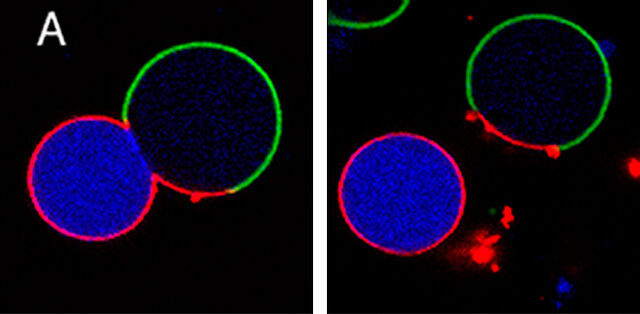Researchers have demonstrated, using a new method in which models of primitive cells are built from the bottom up, that the structures of the cell membrane and the cytoplasm may be just as important for cell division as the specialized components, such as enzymes, DNA or RNA.

Researchers from the Department of Chemistry at Penn State University developed simple, non-living models of cells, with the help of which they discovered that asymmetric division - the process in which a cell divides and becomes two separate daughter cells - is possible even in the absence of the presence of complex components such as genes. The study, published in the scientific journal Journal of the American Chemical Society, may provide important clues to the origin of life from inanimate, non-living components, and to the mechanism by which modern cells have become so complexly behaving over time.
The researcher says that the process by which biological cells divide into asymmetric daughter cells with very different compositions is quite unknown. Cell differentiation - the process by which non-specialized cells, such as stem cells, become specialized cells - requires that different biological components be recognized by each of the daughter cells. For this complex task to be accomplished, several important mechanisms must direct both the recognition of the cellular components and the preservation of polarity (the ability of a cell to exhibit different back and front sides in their properties). "Many genes affect the preservation of cell polarity and the promotion of division into non-identical daughter cells. "Thanks to changes in the expression of these genes, a skin cell becomes a skin cell and a heart cell becomes a heart cell," explains the researcher. "However, our research took a different approach. We asked ourselves: In addition to the genetic factors that direct asymmetric cell division and the existence of polarity, what are the structural and biophysical factors that may also take part in this mechanism, and how did these factors promote the development of complex genetic systems that exist in contemporary cells?"
The team began its research with the assumption that since the new daughter cells are obtained from the division of existing mother cells, a certain original material - such as the cell membrane - could be used as a type of information unit. This unit can initiate and direct a chain of chemical events associated with orderly cell division and polarity maintenance. In order to test this hypothesis, the researchers built model cells from the bottom up, allowing water, lipids, and polymers to cluster together into structures that mimic the most basic components of real living cells, such as cell membranes and cytoplasm. In the next step, they changed the osmotic pressure outside these cells by adding sugar, a change that forced them to divide in a way reminiscent of how living biological cells divide under normal conditions.
"We saw that even model cells can divide in an orderly manner, a finding that suggests a kind of internal order," explains the lead researcher. She explains and says that, similar to a biological cell, the model's mother cell was designed to exhibit asymmetries in both the cell membrane and its cellular contents. The membrane asymmetry was modeled through the use of two distinct fatty moieties, while the cellular content was modeled through the use of two distinct types of polymers known as polyethylene glycol and dextran. The researchers discovered that when the mother cell of the model divided, one daughter cell "inherited" one type of fat surrounding the polyethylene glycol-rich content, and the other daughter cell "inherited" the other type of fat surrounding the dextran-rich content. "And most importantly, we also found that when we changed the relative size of the two lipid parts, one daughter cell "inherited" both types of membranes and the other daughter cell "inherited" only one type," the researcher points out.
The researchers noted that the innovative modeling method seems to imply that simple chemical and physical interactions occurring inside the cells - such as self-assembly, phase separation, and division into two components, may lead to relatively complex behaviors - such as asymmetric division - even when no additional cellular mechanism is present.
"Since we did not add nucleic acids (DNA/RNA) or enzymes to the mixture, it is clear that there were no genes that controlled the behavior of the cells," explains the researcher. "So our study supports the hypothesis that structural and sequence signals work in coordination with genetic signals to obtain and maintain cell polarity through successive division cycles."
The researchers point out that experiments with non-living model cells that do not contain DNA at all, could help and point to clues that explain the mysterious process of abiogenesis, the formation of a living organism from inanimate matter, an event that occurred at least once during the history of the earth . "Scientists succeeded in imitating the conditions that existed on Earth before the appearance of life in laboratories and showed that many amino acids - the biochemical building blocks of proteins - can be produced from natural chemical reactions," explains the lead researcher.
"We hope that our research can help complete another part of the puzzle: how chemical and spatial organization may contribute to the success of the development of ancient life forms on Earth."

One response
We learn every day how much we don't know